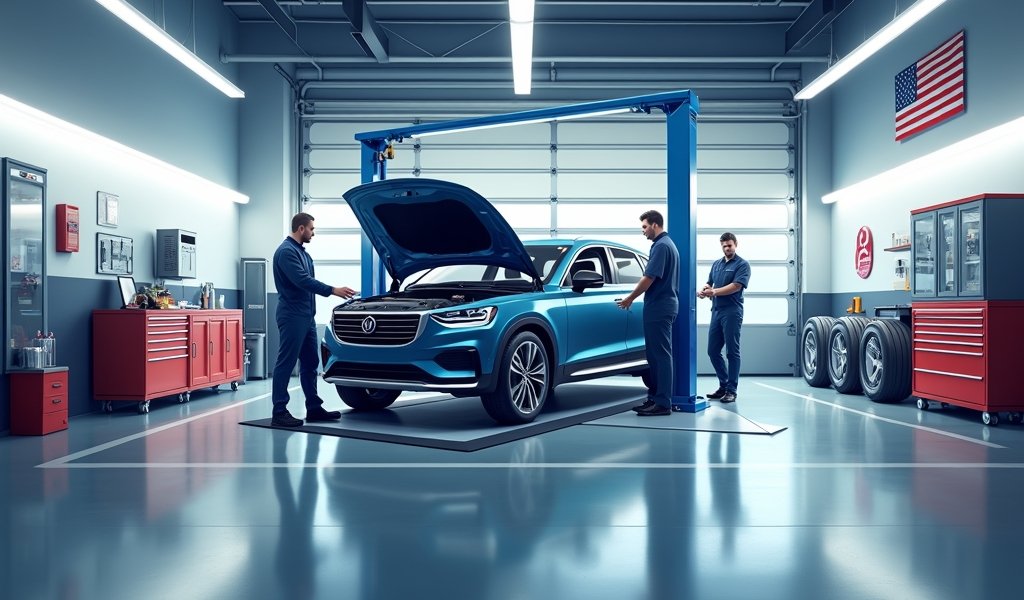Overview
This article outlines seven essential fleet vehicle maintenance strategies: implementing preventative maintenance schedules, leveraging management technology, training drivers as early problem detectors, building reliable service networks, making data-driven decisions, standardizing fleet vehicles, and treating maintenance as an investment rather than an expense. The author emphasizes that proactive maintenance significantly reduces costs, prevents operational disruptions, and extends vehicle lifespans compared to reactive approaches.
Table of Contents
- Understanding Fleet Vehicle Maintenance
- Implement Regular Preventative Maintenance Schedules
- Leverage Technology for Fleet Management
- Train Drivers to Be Your First Line of Defense
- Build a Reliable Service Network
- Make Data-Driven Maintenance Decisions
- Standardize Your Fleet When Possible
- Conclusion
- Frequently Asked Questions
Understanding Fleet Vehicle Maintenance
After 25 years under the hood, I’ve seen firsthand how proper fleet vehicle maintenance can make or break an operation. When you’re managing multiple vehicles, the stakes are higher than with your personal car. A single breakdown doesn’t just strand one driver – it can disrupt your entire business, disappoint customers, and hit your bottom line hard.
Fleet maintenance isn’t just about fixing what’s broken. It’s about creating systems that prevent problems before they happen. According to the Federal Motor Carrier Safety Administration, vehicle-related factors contribute to approximately 10% of all commercial vehicle crashes. Many of these incidents could be prevented with proper maintenance protocols.
Whether you’re managing three delivery vans or three hundred semi-trucks, these seven proven maintenance strategies will help keep your fleet running smoothly, safely, and cost-effectively. Let’s dive into the nuts and bolts of fleet excellence.
Implement Regular Preventative Maintenance Schedules
If there’s one thing I’ve hammered into apprentice mechanics over the years, it’s that prevention beats repair every time. Reactive maintenance – waiting until something breaks – is the costliest approach in the long run. When you’re running a fleet, unplanned downtime is the enemy.
Create a detailed maintenance schedule based on manufacturer recommendations, but adjusted for your specific operating conditions. Heavy-duty use, extreme temperatures, or rough terrain might mean more frequent service intervals. Your schedule should include:
- Oil changes and fluid checks
- Brake system inspections
- Tire rotation, alignment and pressure checks
- Battery testing and electrical system inspections
- Fuel system and filter maintenance
- Cooling system service
- Transmission service
Don’t just create the schedule – enforce it religiously. Even when operations get busy, sticking to maintenance schedules by mileage pays dividends. One missed oil change might seem minor, but multiply that across dozens of vehicles and you’re setting yourself up for costly repairs down the road.
The beauty of preventative maintenance is that it’s predictable. You can schedule it during off-hours or slower periods, minimizing the impact on your operations. Contrast that with emergency repairs, which always seem to happen at the worst possible moment.

Leverage Technology for Fleet Management
You don’t need to track maintenance with clipboards and filing cabinets anymore. Modern fleet management software has transformed how we approach vehicle care. These digital tools help you stay ahead of maintenance needs, track costs, and identify patterns that might otherwise go unnoticed.
A good fleet management system should allow you to:
- Schedule and track maintenance for each vehicle
- Set automated reminders for upcoming service
- Record service history with detailed notes
- Monitor fuel consumption and efficiency
- Track repair costs and parts inventory
- Generate reports to identify problem vehicles or recurring issues
Telematics systems take this a step further by providing real-time data on vehicle performance. Modern OBD-II monitors can alert you to potential issues before they become major problems. I’ve seen engine sensors flag cooling system issues days before they would have caused an overheat situation – saving thousands in potential engine damage.
Even small fleets can benefit from these technologies. Many affordable cloud-based solutions now exist that don’t require massive IT investments. The data these systems provide will help you make smarter decisions about when to repair, when to replace, and how to optimize your maintenance budget.
Train Drivers to Be Your First Line of Defense
Your drivers interact with your vehicles every day, making them your most valuable early warning system for potential problems. A well-trained driver can spot issues before they become serious – if they know what to look for.
Develop a comprehensive training program that teaches drivers how to:
- Perform thorough pre-trip and post-trip inspections
- Recognize unusual sounds, smells, or vibrations
- Check fluid levels and tire condition properly
- Understand dashboard warning lights and what they mean
- Document and report issues clearly
Make reporting maintenance concerns easy. Complicated paperwork or cumbersome processes discourage drivers from flagging potential issues. Many fleets now use mobile apps where drivers can quickly report problems, even attaching photos or videos of concerning symptoms.
Remember that your drivers aren’t mechanics – and they shouldn’t be expected to be. The goal isn’t diagnosis, but detection. Train them to report what they observe without attempting amateur repairs. Clear communication between drivers and maintenance staff is worth its weight in gold.
I’ve seen routine vehicle maintenance issues caught early by attentive drivers save fleets thousands in potential repair costs. That strange clicking noise a driver reported? It was a failing CV joint that would have left the vehicle stranded if allowed to progress. The slight pull to the right another driver mentioned? A tire showing unusual wear patterns that indicated alignment issues affecting fuel economy.
Build a Reliable Service Network
Unless you have a large in-house maintenance operation, you’ll need trusted service partners. Finding reliable shops that understand commercial vehicles can be challenging, but it’s worth the effort. A good service relationship is built on trust, communication, and mutual benefit.
Consider these factors when selecting service partners:
- Experience with your specific vehicle types and systems
- Technician certifications and ongoing training
- Availability of emergency service and mobile repair
- Transparent pricing and detailed invoicing
- Communication practices and scheduling flexibility
- Parts quality and warranty policies
Don’t just choose the cheapest option. That bargain service center might cost you more in the long run through incomplete repairs or poor-quality parts. I’ve seen fleets chase the lowest hourly rate only to have vehicles return repeatedly with the same issues.
For fleets operating across regions, national service networks can provide consistency. Many offer centralized billing and reporting, which simplifies your administrative burden. Research shows that preventive maintenance can reduce overall operating costs by up to 25% compared to reactive maintenance approaches.
Wherever possible, build relationships with the technicians who actually work on your vehicles. They’ll be more likely to give your fleet priority attention during busy periods, and they’ll develop valuable familiarity with your vehicles’ specific quirks and history.

Make Data-Driven Maintenance Decisions
Gut feelings have their place in vehicle maintenance, but data tells the real story. By tracking key metrics across your fleet, you can spot trends and make informed decisions about maintenance practices, vehicle replacement, and budget allocation.
Important metrics to monitor include:
- Cost per mile for maintenance and repairs
- Downtime frequency and duration
- Mean time between failures
- Repair frequency by vehicle and component
- Fuel efficiency trends
- Service compliance rates
These numbers help you identify problem vehicles that might need replacement sooner than planned. If one van in your fleet consistently costs twice as much to maintain as others of the same age and mileage, it might be time to retire it.
Data also helps you evaluate your maintenance strategies. If you’ve recently changed your preventative maintenance schedule, track the impact on breakdown frequency and repair costs. The numbers will tell you whether the change was beneficial.
Don’t overlook warranty recovery. Many fleets leave money on the table by failing to claim warranty coverage for qualified repairs. Good record-keeping ensures you can provide the documentation needed for successful warranty claims.
Standardize Your Fleet When Possible
After maintaining thousands of fleet vehicles, I can tell you with certainty: standardization simplifies everything. When your vehicles share makes, models, and configurations, maintenance becomes more efficient and cost-effective.
Benefits of fleet standardization include:
- Simplified technician training and specialization
- Streamlined parts inventory and bulk purchasing opportunities
- Consistent maintenance procedures and schedules
- Interchangeable components between vehicles
- Better familiarity for drivers who switch vehicles
- More accurate performance benchmarking
I understand that perfect standardization isn’t always possible. Different operational needs might require various vehicle types. But even standardizing within categories (all light-duty trucks from one manufacturer, all vans from another) can yield significant benefits.
When considering new vehicle purchases, factor maintenance simplicity into your decision. Sometimes paying a bit more upfront for vehicles that align with your existing fleet makes economic sense in the long run.
Standardization extends beyond vehicle selection to maintenance practices as well. Consistent procedures, documented in clear checklists and guides, ensure that no matter who performs the work, critical steps aren’t missed.
Conclusion
Effective fleet vehicle maintenance isn’t rocket science, but it does require commitment and systems. The seven strategies we’ve covered – preventative scheduling, technology adoption, driver training, service partnerships, data analysis, standardization, and lifecycle management – work together to create a maintenance program greater than the sum of its parts.
Remember that maintenance is an investment, not just an expense. Every dollar spent on preventative care typically saves several dollars in emergency repairs and operational disruption. Your vehicles are assets that power your business – treat them accordingly.
Start where you are. If your current maintenance approach is mostly reactive, begin by implementing basic preventative schedules. If you already have good practices in place, look for opportunities to leverage technology or improve data analysis.
The road to fleet excellence is a journey, not a destination. Keep learning, adapting, and improving your maintenance practices. Your bottom line – and your customers – will thank you for it.
Frequently Asked Questions
How often should fleet vehicles receive maintenance service?
Most light-duty fleet vehicles should receive basic service every 5,000-7,000 miles or according to manufacturer recommendations. Heavy-duty vehicles may require more frequent service based on operating conditions and usage patterns.
What’s the biggest maintenance mistake fleet managers make?
The most common mistake is skipping preventative maintenance to save time or money in the short term. This false economy leads to more expensive repairs, increased downtime, and shortened vehicle lifespan.
How can I reduce fleet maintenance costs without compromising vehicle reliability?
Implement rigorous preventative maintenance schedules, train drivers to report issues early, standardize your fleet when possible, and use data analytics to identify problem vehicles. Addressing issues before they become major failures is always more cost-effective.
Should I outsource fleet maintenance or build an in-house maintenance facility?
This depends on your fleet size, budget, and operational needs. Smaller fleets typically benefit from outsourcing to trusted service partners, while larger operations with 50+ vehicles may find in-house facilities more cost-effective long-term.
How do I know when to replace a fleet vehicle rather than continue repairing it?
Track the total cost of ownership, including maintenance costs per mile, downtime frequency, and reliability impacts on your operation. When maintenance costs consistently exceed 15% of the vehicle’s current value annually, replacement often makes more financial sense.

